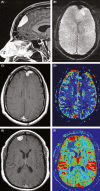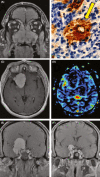Differentiation of intracranial Rosai-Dorfman histiocytosis from meningioma using MR perfusion
- PMID: 35441021
- PMCID: PMC9010961
- DOI: 10.1002/ccr3.5737
Differentiation of intracranial Rosai-Dorfman histiocytosis from meningioma using MR perfusion
Abstract
Intracranial Rosai-Dorfman disease may be indistinguishable from meningioma. This distinction is essential, as they are treated very differently. We present two cases where perfusion imaging helped make this distinction, allowing one to be treated successfully without craniotomy. Perfusion imaging may be a powerful adjunct in cases where RDD mimics meningioma.
Keywords: MR perfusion; Rosai‐Dorfman disease; histiocytosis; meningioma.
© 2022 The Authors. Clinical Case Reports published by John Wiley & Sons Ltd.
Conflict of interest statement
The authors have no personal, financial, or institutional disclosures in relation to this article.
Figures



References
-
- Foucar E, Rosai J, Dorfman R. Sinus histiocytosis with massive lymphadenopathy (Rosai‐Dorfman disease): review of the entity. Semin Diagn Pathol. 1990;7:19‐73. - PubMed
-
- Andriko J‐AW, Morrison A, Colegial CH, Davis BJ, Jones RV. Rosai‐Dorfman disease isolated to the central nervous system: a report of 11 cases. Mod Pathol. 2001;14:172‐178. - PubMed
-
- Zhu H, Qiu L‐H, Dou Y‐F, et al. Imaging characteristics of Rosai‐Dorfman disease in the central nervous system. Eur J Radiol. 2012;81:1265‐1272. - PubMed
-
- Rosai J, Dorfman RF. Sinus histiocytosis with massive lymphadenopathy. A newly recognized benign clinicopathological entity. Arch Pathol. 1969;87:63‐70. - PubMed
Publication types
LinkOut - more resources
Full Text Sources

